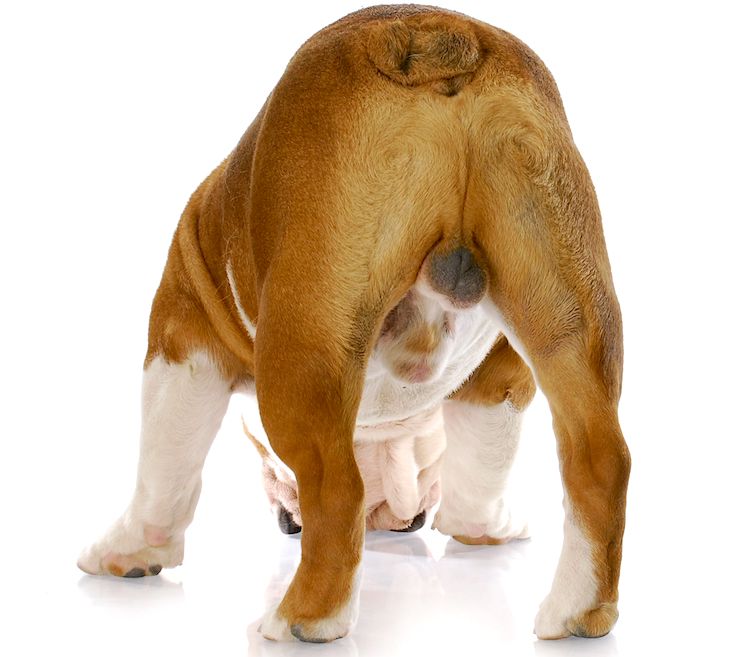
“Down below,” “down there,” “his junk,” “my dog’s nuts” …
These are some of the more polite euphemisms people (especially guys) use with a veterinarian when alluding to problems of a testicular nature.
Me, the veterinarian? Well, I prefer to cut to the chase with the correct anatomical term: “testicles.”
In this article about what it means when a cat or a dog has a missing testicle, I will reveal:
- The age at which your pet’s testicles should appear
- What causes the missing testicle
- The health implications of a missing testicle
- What you should do about a missing testicle in your dog or cat

What’s Normal and What’s Not
We’re all familiar with what an intact male dog looks like: There should be 2 testicles of equal size sitting in a scrotum that’s below or away from the body.
Male cats have a similar setup, except their scrotum sits under the tail, is often furry, and therefore can be more difficult to see.
This anatomical arrangement is a practical way of keeping the testicles cool. Healthy sperm production (which is, after all, the role of the testicle) requires the testes to be kept slightly cooler than the rest of the body — which is why they are slung in a jaunty manner down below.
What’s not normal is when only one scrotal testicle is present (where is the other one?) or there are no testicles at all (and yet the pup hasn’t been neutered).
Actually, there are technical terms for this:
- Monorchid: Only one scrotal testicle
- Cryptorchid: One or no scrotal testicles
Next, let’s take a look at what causes a missing testicle …
What Causes a Missing Testicle in Dogs and Cats?
As the fetal puppy grows, those teeny-tiny testicles start to develop near the kidney.
A ligament attached to one end of each testicle contracts. The ligament draws the testicle through abdomen, out of the inguinal canal, to eventually drop down into the scrotum.
But sometimes this ligament does only a partial job. The testicle is dragged part the way through the tummy but then stalls. This is why that errant missing testicle may be found anywhere from just under the skin by the scrotum to the groin or even inside the abdomen.
The deeper question is why does this mechanism fail?
This has a strong inherited factor, with a cyrptorchid father at risk of siring cryptorchid pups. This is why it’s important that affected dogs aren’t used for breeding.
Testicular Trivia
- Cryptorchidism is fairly common in dogs, with about 7% of male dogs (but only 1% of male cats) affected
- Unilateral (one testicle present) is much more common than bilateral (no testicles present)
- Most normal dogs have a pair of scrotal testes present by 8 weeks of age
- The right testicle is twice as likely as the left to not descend
- Small breeds carry an almost 3 times greater risk of being cryptorchid than large breeds.
Breeds Most at Risk
Dog breeds with the highest risk of cryptorchidism include:
It seems strange that the Siberian Husky, a large dog, is on the list above. But then again, my most recent patient dog with a missing testicle was a husky. Interesting.
Was YOUR Pet Food Recalled?
Check Now: Blue Buffalo • Science Diet • Purina • Wellness • 4health • Canine Carry Outs • Friskies • Taste of the Wild • See 200+ more brands…

What’s All the Fuss About a Missing Testicle?
The reason we worry about a missing testicle is that there are health implications for the dog. These are:
- An increased risk of testicular cancer
- Torsion of the retained testicle
Let’s consider these in more detail.
The Risk of Testicular Cancer
Remember how the scrotum is there to keep the testicles cool?
Well, a retained testicle is like an egg in a too-warm incubator. For a testicle the increased warmth increases the risk of cell mutation and cancer.
The main cancer we worry about is something called a Sertoli cell tumor (these make up about 60% of canine testicular cancers).
In what is the ultimate act of irony, 25% of Sertoli cell tumors produce female hormones. This means affected dogs often show feminization syndrome. Signs include:
- Hair loss
- Enlarged mammary glands
- Male genitalia decreases in size
More serious still, the raised levels of estrogen in some cases suppress the bone marrow, causing serious anemia.
The good news is the vast majority of these tumors (roughly 90%) are benign, meaning they don’t spread cancer to the rest of the body. Removing (both) testicles is usually curative.
However, if you are a pessimist, there’s a 10% chance of malignancy. This means spread of the cancer and chance of premature death.
Testicular cancer isn’t necessarily all about old dogs. The statistics show that around 8–9 years of age is the average for this condition to develop.
The good news is, if the cancer is benign, then surgery to remove both testicles should be curative. Give it time and the signs of feminization ebb away and the dog’s coat should regrow.
Testicular Torsion
This is as it sounds. The retained testicle is often “bouncing” around in the abdomen.
Think of it like a yo-yo on the end of a string. For an unlucky few, during the course of play, the testicle spins around on its blood supply to cut it off.
Testicular torsion in a dog can happen suddenly and the animal becomes very ill, very quickly. However, the signs can be vague … as vague as a severe stomachache.
Reaching a diagnosis takes time and money.
A particular case of a missing testicle sticks in my mind. A large Rottweiler with a retained testicle had developed unpredictable behavior, so his caregiver had booked him for surgery.
When I opened the dog’s abdomen, the missing testicle was hugely swollen and starved of blood due to very recent torsion. Had the dog not been booked that very day, we surely would have seen him for emergency surgery that night.
Testicular torsion can happen at any age, but it often happens in young dogs.
Here’s a quick video that shows a dog with a missing testicle and explains more:

Treating Missing Testicles in Dogs
The best option is surgery, which involves tracking down and removing the dog’s missing testicle, plus removing the scrotal one.
There are several reasons for removing the scrotal testicle:
- It carries a higher risk of becoming cancerous.
- It is unethical to breed from a cryptorchid animal.
- Not removing the scrotal testicle could mean unnecessary surgery if the dog changed hands and the dog’s new family wasn’t aware of the original surgery.
Surgery involves a general anesthetic. The dog is usually given a sedative pre-med, often composed of 2 excellent painkillers.
Once the patient is under the anesthetic, the vet clips up the fur and has a good feel around the groin to detect the missing testicle under the skin.
- If the dog is lucky, the retained testicle is sitting in the groin and the procedure to remove it is relatively minor.
- If the dog is unlucky, the testicle is fully retained in the abdomen. This requires a more invasive surgery where the abdomen is opened. An abdominal testicle may be located anywhere along its normal migratory path. So the vet will start a systematic search from the bladder to the kidney to locate it.
My Dog Has a Missing Testicle … When Should I Worry?
As mentioned earlier, most normal puppies and kittens have 2 scrotal testicles present by the age of 2 months. However, some dogs and cats are slow developers.
My preference is to give the animal until they are at least 6 months old before making the call. If the missing testicle hasn’t put in an appearance by then, it’s not going to.
That being the case, if you do have a cryptorchid pet, don’t panic — but do take them in for surgery.
Not only does surgery save them from potential health problems further down the line, but it means they won’t pass on the faulty gene to the next generation to cause further heartache.

A Parting Word About Cats
Male cats can be cryptorchid just like dogs.
However, with cats there’s the additional factor of spraying.
It’s not good to have a male cat doctored and just remove the scrotal testicle. That retained testicle will happily push out testosterone, keeping hormone levels high and causing the cat to spray and mark their territory.
If you have adopted an adult male cat who sprays, then talk with your vet about it. They may be able to run a blood test to detect higher-than-expected hormone levels in a neutered male. If this is the case, then exploratory surgery should locate the testicle and give you a fighting chance of breaking the spraying habit.
If you have a male kitten with a missing testicle, the health implications are similar to those with a dog. Don’t cut corners.
Instead, let your vet search for the missing testicle so it doesn’t affect the cat’s health later.
References
- Threlfall, Walter, DVM, PhD. “Anatomy of the Male, Female, and Everything in Between (Proceedings).” dvm360. Nov. 1, 2009. http://veterinarycalendar.dvm360.com/anatomy-male-female-and-everything-between-proceedings-0.
- Yates, David, BVSc, et al. “Incidence of Cryptorchidism in Dogs and Cats.” Veterinary Record 152, no. 16 (April 2003): 502–504. https://veterinaryrecord.bmj.com/content/152/16/502.
- Llera, Ryan, DVM, et al. “Retained Testicle (Cryptorchidism) in Dogs.” VCA Hospitals. 2018. https://vcahospitals.com/know-your-pet/retained-testicle-cryptorchidism-in-dogs.
- Tibary, Ahmed, DMV, PhD, DACT. “Male Genital Abnormalities.” Merck Veterinary Manual. https://www.msdvetmanual.com/reproductive-system/congenital-and-inherited-anomalies-of-the-reproductive-system/male-genital-abnormalities.
- Khan, Firdous Ahmad, BVSc, MVSc, DVSc, Dipl. ACT, et al. “Canine Cryptorchidism: An Update.” Reproduction in Domestic Animals 53, no. 6 (December 2018): 1263–1270. https://pubmed.ncbi.nlm.nih.gov/29956390/.
 This pet health content was written by a veterinarian, Dr. Pippa Elliott, BVMS, MRCVS. It was last reviewed Aug. 27, 2019.
This pet health content was written by a veterinarian, Dr. Pippa Elliott, BVMS, MRCVS. It was last reviewed Aug. 27, 2019. 

